Topseller
-
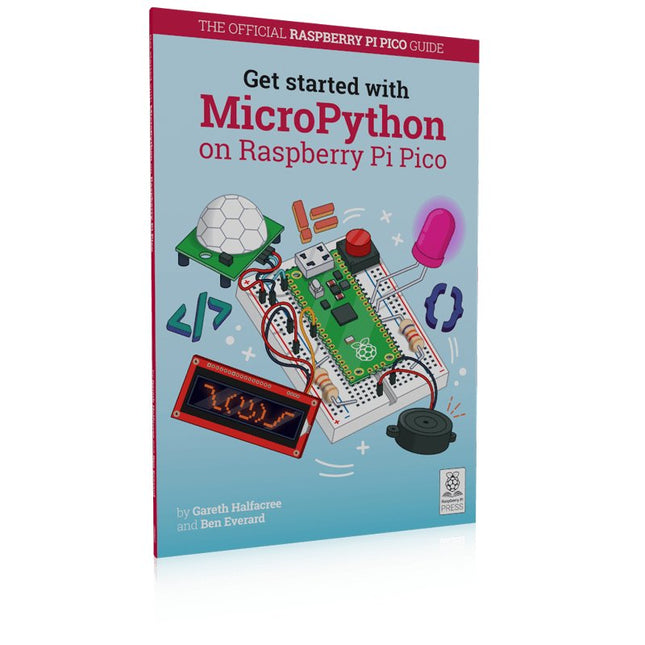
Raspberry Pi Foundation Get Started with MicroPython on Raspberry Pi Pico
In Get Started with MicroPython on Raspberry Pi Pico, you will learn how to use the beginner-friendly language MicroPython to write programs and connect up hardware to make your Raspberry Pi Pico interact with the world around it. Using these skills, you can create your own electro‑mechanical projects, whether for fun or to make your life easier. Microcontrollers, like RP2040 at the heart of Raspberry Pi Pico, are computers stripped back to their bare essentials. You don’t use monitors or keyboards, but program them to take their input from, and send their output to the input/output pins. Using these programmable connections, you can light lights, make noises, send text to screens, and much more. In Get Started with MicroPython on Raspberry Pi Pico, you will learn how to use the beginner-friendly language MicroPython to write programs and connect up hardware to make your Raspberry Pi Pico interact with the world around it. Using these skills, you can create your own electro‑mechanical projects, whether for fun or to make your life easier. The robotic future is here – you just have to build it yourself. We’ll show you how. About the authors Gareth Halfacree is a freelance technology journalist, writer, and former system administrator in the education sector. With a passion for open-source software and hardware, he was an early adopter of the Raspberry Pi platform and has written several publications on its capabilities and flexibility. Ben Everard is a geek who has stumbled into a career that lets him play with new hardware. As the editor of HackSpace magazine, he spends more time than he really should experimenting with the latest (and not-solatest) DIY tech.
€ 19,95€ 9,95
Mitglieder identisch
-
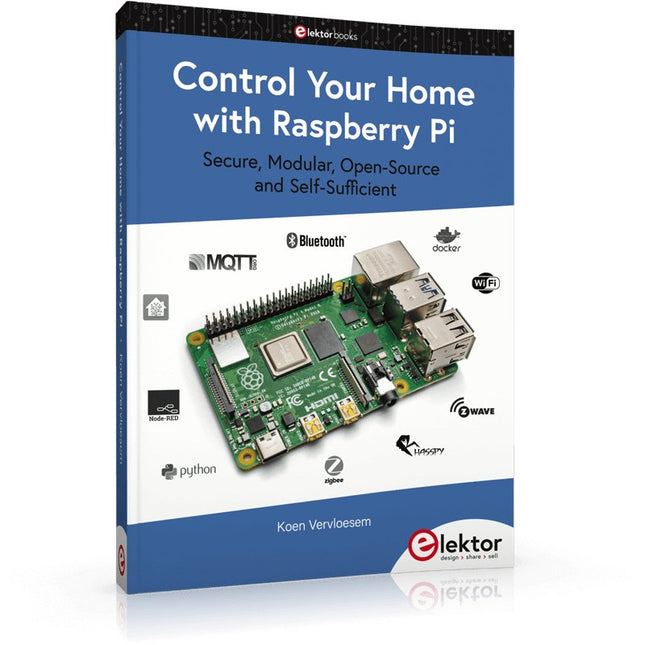
Elektor Publishing Control Your Home with Raspberry Pi
Secure, Modular, Open-Source and Self-Sufficient Ever since the Raspberry Pi was introduced, it has been used by enthusiasts to automate their homes. The Raspberry Pi is a powerful computer in a small package, with lots of interfacing options to control various devices. This book shows you how you can automate your home with a Raspberry Pi. You’ll learn how to use various wireless protocols for home automation, such as Bluetooth, 433.92 MHz radio waves, Z-Wave, and Zigbee. Soon you’ll automate your home with Python, Node-RED, and Home Assistant, and you’ll even be able to speak to your home automation system. All this is done securely, with a modular system, completely open-source, without relying on third-party services. You’re in control of your home, and no one else. At the end of this book, you can install and configure your Raspberry Pi as a highly flexible home automation gateway for protocols of your choice, and link various services with MQTT to make it your own system. This DIY (do it yourself) approach is a bit more laborious than just installing an off-the-shelf home automation system, but in the process, you can learn a lot, and in the end, you know exactly what’s running your house and how to tweak it. This is why you were interested in the Raspberry Pi in the first place, right? Turn your Raspberry Pi into a reliable gateway for various home automation protocols. Make your home automation setup reproducible with Docker Compose. Secure all your network communication with TLS. Create a video surveillance system for your home. Automate your home with Python, Node-RED, Home Assistant and AppDaemon. Securely access your home automation dashboard from remote locations. Use fully offline voice commands in your own language. Downloads Errata on GitHub
€ 44,95
Mitglieder € 40,46
-
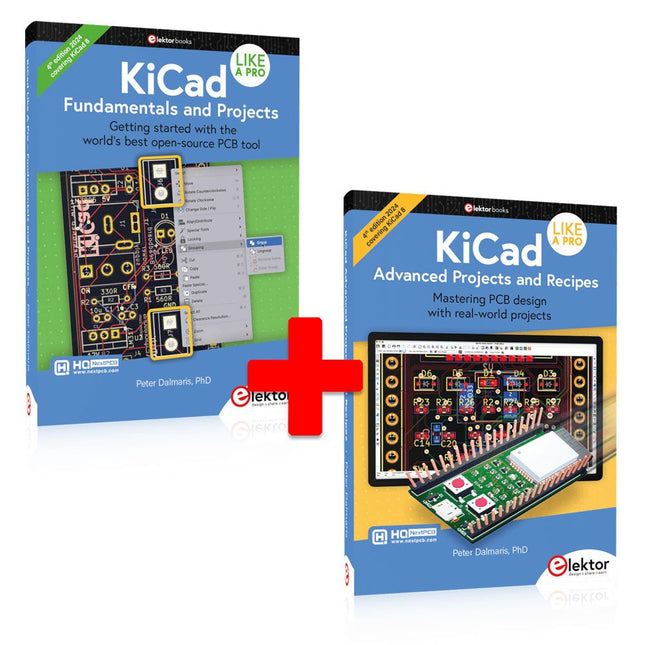
Elektor Bundles KiCad Like A Pro (Bundle)
Dieses Bundle enthält beide Bände von "KiCad Like a Pro" (4. Ausgabe 2024). In Fundamentals and Projects (Einzelpreis: 49,95 €) lernen Sie den praktischen Umgang mit KiCad kennen, sodass Sie schnell produktiv werden und mit dem Entwurf Ihrer eigenen Boards beginnen können. Mit Advanced Projects and Recipes (Einzelpreis: 44,95 €) können Sie Ihre neuen KiCad-Kenntnisse üben, indem Sie sich selbst mit einer Reihe realer Projekte herausfordern. Die neueste Version von KiCad, dem weltweit besten kostenlosen PCB-Tool, ist vollgepackt mit Funktionen, die normalerweise nur in teuren kommerziellen CAD-Tools zu finden sind. Diese moderne, plattformübergreifende Anwendungssuite, die auf Schaltplan- und Designeditoren mit Zusatzanwendungen basiert, ist ein stabiles und ausgereiftes PCB-Tool. KiCad 8 ist perfekt für Elektronikingenieure und -hersteller geeignet. Hier sind die wichtigsten Verbesserungen und Funktionen in KiCad 8, sowohl über als auch unter der Haube: Moderne Benutzeroberfläche, im Vergleich zu früheren Versionen komplett neu gestaltet Verbesserte und anpassbare Prüffunktionen für elektrische und Designregeln Designeditor, mit dem Sie KiCad auf Ihrem Bildschirm anpassen können Möglichkeit zum Importieren von Projekten aus Eagle, CADSTART und mehr Python-Skripting-API Verbesserter integrierter SPICE-Schaltkreissimulator Mehrblatt-Schaltpläne Filter definieren auswählbare Elemente Verbesserter interaktiver Router hilft Ihnen, einzelne Spuren und Differenzialpaare präzise zu zeichnen Neue oder verbesserte Tools zum Zeichnen von Spuren, Messen von Entfernungen, Anpassen von Spurlängen usw. Erweiterte interaktive Router Integrierter Stücklistengenerator Realistischer Raytracing-fähiger 3D-Viewer Anpassbare Teardrops Plug-in-Manager für die schnelle Installation von Designs, Bibliotheken und Funktionen wie Autoroutern und Stücklistengeneratoren Das erste Buch KiCad Like A Pro – Fundamentals and Projects bringt Ihnen den Umgang mit KiCad durch einen praktischen Ansatz bei. Es wird Ihnen helfen, schnell produktiv zu werden und mit dem Entwurf Ihrer eigenen Platinen zu beginnen. Beispielprojekte veranschaulichen die grundlegenden Funktionen von KiCad, auch wenn Sie keine Vorkenntnisse im PCB-Design haben. Der Autor beschreibt den gesamten Arbeitsablauf von der Schaltplaneingabe bis zu den Feinheiten der Fertigstellung der Dateien für die PCB-Produktion und bietet fundierte Anleitungen für den Prozess. Das zweite Buch KiCad Like A Pro – Advanced Projects and Recipes hilft Ihnen, Ihre neuen KiCad-Kenntnisse zu üben, indem es Sie in einer Reihe realer Projekte herausfordert. Die Projekte werden durch einen umfassenden Satz von Rezepten mit detaillierten Anweisungen zur Erledigung einer Vielzahl einfacher und komplexer Aufgaben unterstützt. Entwerfen Sie die Platine für eine Solarstromversorgung, ein LED-Matrix-Array, einen Arduino-betriebenen Datenlogger und eine benutzerdefinierte ESP32-Platine. Lernen Sie die Feinheiten des interaktiven Routers kennen, erfahren Sie, wie Sie KiCad-Projektteams mit Git verwalten, wie Sie einen Autorouter auf 2- und 4-lagigen Platinen verwenden und vieles mehr.
€ 104,95€ 84,95
Mitglieder identisch
-
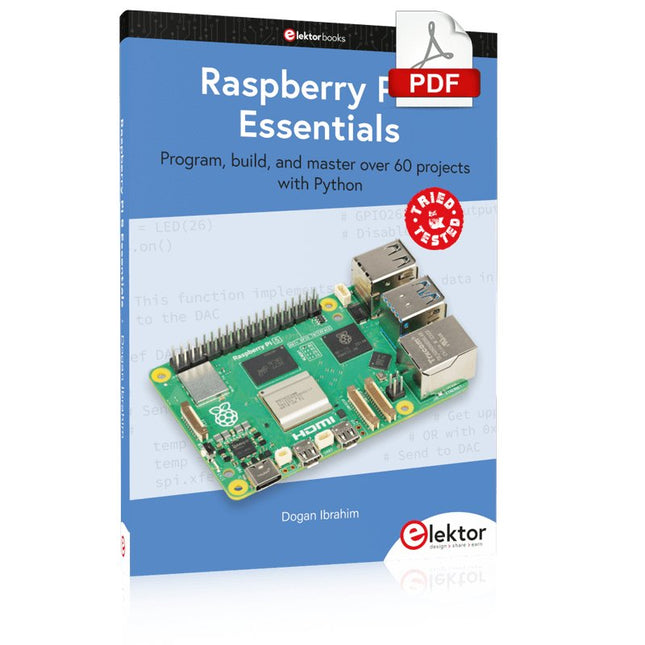
Elektor Digital Raspberry Pi 5 Essentials (E-book)
Program, build, and master over 60 projects with Python The Raspberry Pi 5 is the latest single-board computer from the Raspberry Pi Foundation. It can be used in many applications, such as in audio and video media centers, as a desktop computer, in industrial controllers, robotics, and in many domestic and commercial applications. In addition to the well-established features found in other Raspberry Pi computers, the Raspberry Pi 5 offers Wi-Fi and Bluetooth (classic and BLE), which makes it a perfect match for IoT as well as in remote and Internet-based control and monitoring applications. It is now possible to develop many real-time projects such as audio digital signal processing, real-time digital filtering, real-time digital control and monitoring, and many other real-time operations using this tiny powerhouse. The book starts with an introduction to the Raspberry Pi 5 computer and covers the important topics of accessing the computer locally and remotely. Use of the console language commands as well as accessing and using the desktop GUI are described with working examples. The remaining parts of the book cover many Raspberry Pi 5-based hardware projects using components and devices such as LEDs and buzzers LCDs Ultrasonic sensors Temperature and atmospheric pressure sensors The Sense HAT Camera modules Example projects are given using Wi-Fi and Bluetooth modules to send and receive data from smartphones and PCs, and sending real-time temperature and atmospheric pressure data to the cloud. All projects given in the book have been fully tested for correct operation. Only basic programming and electronics experience are required to follow the projects. Brief descriptions, block diagrams, detailed circuit diagrams, and full Python program listings are given for all projects described.
€ 32,95
Mitglieder € 26,36
-
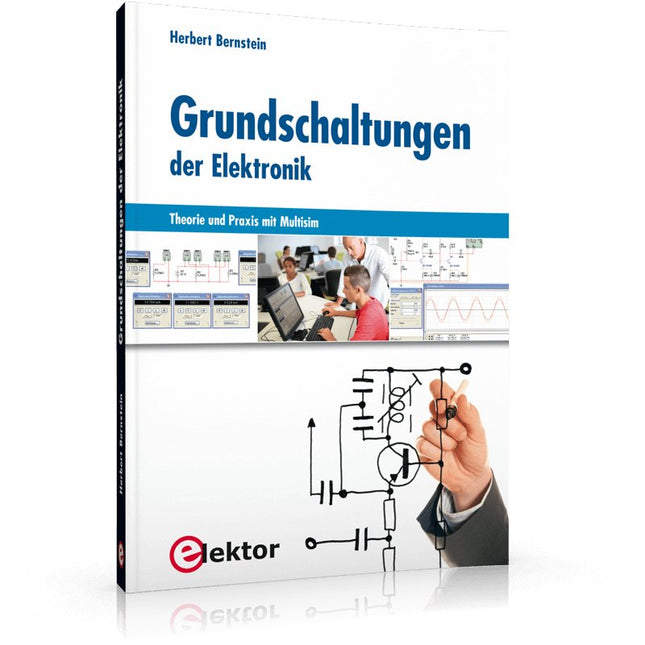
Elektor Publishing Grundschaltungen der Elektronik
Dieses Buch ist ein Nachschlagewerk mit praxisorientierten Fakten und ausführlichen Erklärungen. Der Autor hat selbst für komplexe Vorgänge oder Formeln praktische kurze Erklärungen und Näherungsrechnungen entwickelt, ohne die Darstellungen zu simplifizieren. Als Ausgangspunkt wurde das Simulationsprogramm Multisim gewählt, das zahlreiche Bauelemente und umfangreiche Messinstrumente zur Verfügung stellt. Damit hat man ein praxisnahes Fachbuch und Nachschlagewerk für Schule, Studium und Weiterbildung im Beruf. Das Buch ist in sechs Kapitel gegliedert: Messgeräte: Arbeiten mit Multimeter, Funktionsgenerator und Zweikanal-Oszilloskop Dioden: Einweg-, Brückengleichrichter, Schalter, Spannungsbegrenzer, Z-Diode, Leuchtdioden, 7-Segment-, Bargraf-Anzeige und Optokoppler Verstärkerschaltungen: Kleinsignalverstärker, ein- und zweistufige Verstärker, Leistungsverstärker für A-, B- und AB-Betrieb, Wechselstromverstärker, Differenzverstärker, FET-Verstärker und Arbeiten mit dem Operationsverstärker Transistoren: Als Schalter eingesetzt, Schaltungen mit komplementären Transistoren, astabile und monostabile Kippschaltung, Flipflops Signalgeneratoren: Rechteckgenerator, Sägezahngenerator, Dreieck-Rechteck-Generator, Sinusgenerator, LC-Oszillator, Phasenschiebergenerator, Wien-Robinson-Generator, Oszillator mit Quarz Impulsformer mit Schmitt-Trigger und Komparator: Schmitt-Trigger mit Transistoren und FET, Dämmerungsschalter, Temperaturüberwachung, TTL-Baustein 74132, Amplitudenbegrenzer, Differenzier- und Integrierschaltung Der in mehrere Hauptkapitel gegliederte Inhalt ist so aufbereitet, dass Nachschlagen und Finden der gewünschten Themen sehr einfach ist. Neben den passiven Bauelementen (Widerständen, Kondensatoren und Spulen) nehmen die Halbleiterelemente (Dioden, Transistoren und Feldeffekttransistoren) sowie Operationsverstärker und digitale Schaltkreise einen breiten Raum ein.
€ 49,00
Mitglieder identisch
-
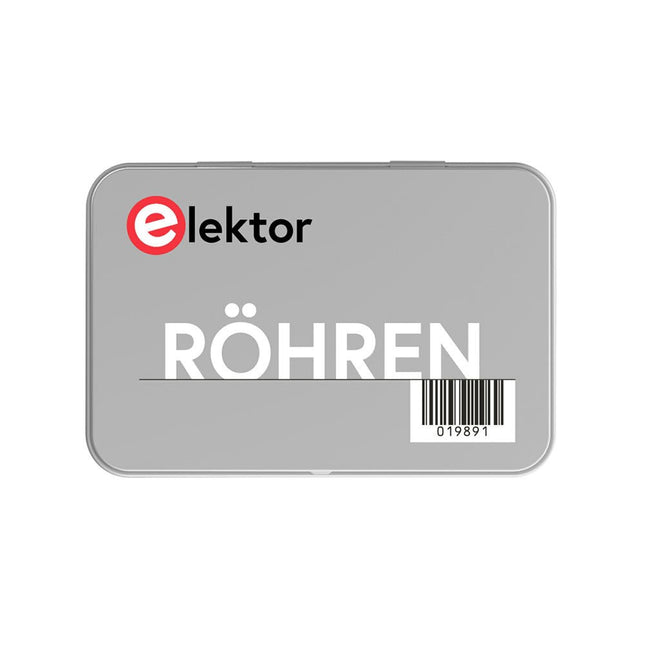
Elektor Classics Elektor Röhren 1 bis 10 (USB-Stick)
Im Digitalzeitalter wird die Technikwelt von hochkomplexen Elektronikelementen dominiert. Sie funktionieren – oder auch nicht. Ganz anders ist es in der Röhrentechnik. Es ist wirklich eine Technik zum Anfassen, wobei sich das Anfassen nicht auf heiße Röhrenkolben und Widerstände bezieht. Der Anwender kann bei entsprechendem technischem Verständnis die Funktion jedes einzelnen Bauteils nachvollziehen. Es lässt sich auch jedes defekte Bauteil einzeln austauschen und so das Gerät wieder zum Laufen bringen: ein Paradies für jeden Elektronikbastler aus Leidenschaft! 2005 brachte der Elektor Verlag sein erstes Röhren-Sonderheft heraus – und es stieß auf ungeahnt starke Resonanz! Die vielen positiven Reaktionen nicht nur von Technik-Begeisterten, sondern auch von Musikern, zeigten dem Verlag, dass die Röhrentechnik lebt! 10 Röhren-Sonderhefte mit unzähligen Selbstbauanleitungen, Schaltplänen und praxisnahen Einsatzberichten zeigen, dass die Röhrentechnik einen festen Platz in der modernen Audio-Technologie hat. Inhalt des USB-Sticks Alle bisher erschienenen 10 Röhren-Sonderhefte 1 bis 10 als PDF Röhrenverstärker-Workshop 1 'Die Kunst, Audio-Röhrenverstärker zu verstehen und zu entwerfen' von und mit Menno van der Veen Röhrenverstärker-Workshop 2 'Die Kunst, Audio-Röhrenverstärker zu messen und zu beurteilen' von und mit Menno van der Veen Technische Daten USB USB 3.0 Speicher 32 GB Anschlüsse 1x USB-A1x USB-C
€ 59,95€ 34,95
Mitglieder identisch
-
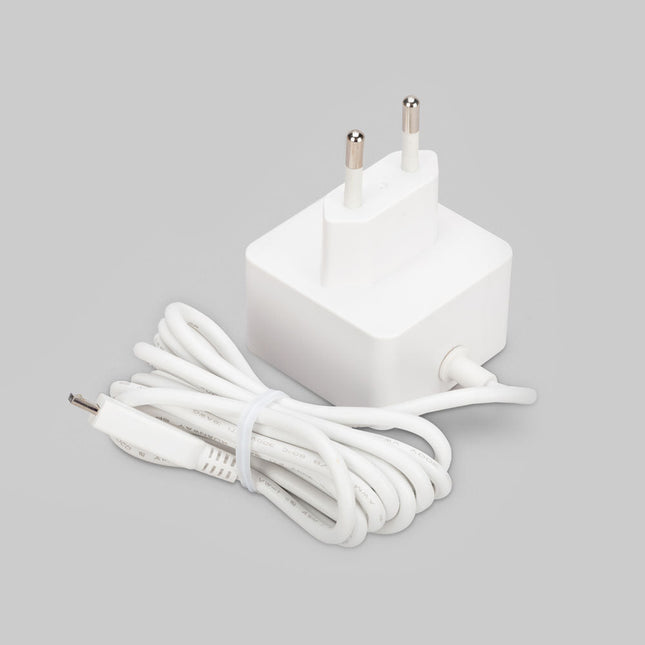
Raspberry Pi Foundation Offizielles Micro-USB-Netzteil für Raspberry Pi
Offizielles Micro-USB-Netzteil für Raspberry Pi (12,5 W) Eingang: 100–240 V Wechselstrom Ausgang: 5,1 V / 2,5 A Netzteil Anschluss: Micro-USB Länge: 1,5 m
€ 9,95
Mitglieder identisch
-

Raspberry Pi Foundation Offizielles 27 W Netzteil für Raspberry Pi 5 (EU, schwarz)
Das Raspberry Pi 27 W PD USB-C-Netzteil wurde speziell für die Stromversorgung des Raspberry Pi 5 entwickelt. Es ist auch in der Lage, 5,1 V/5 A, 9 V/3 A, 12 V/2,25 A, 15 V/1,8 A an PD-kompatible Produkte zu liefern, was es zu einem guten und kostengünstigen Netzteil für viele allgemeine Anwendungen macht, wie zum Beispiel das Laden von Smartphones und Tablets. Technische Daten Eingang 100-240 VAC Ausgang 5,1 V @ 5 A | 9 V @ 3 A | 12 V @ 2,25 A | 15 V @ 1,8 A Anschluss USB-C Länge 1,2 m Farbe Schwarz Region EU
€ 13,95
Mitglieder identisch
-
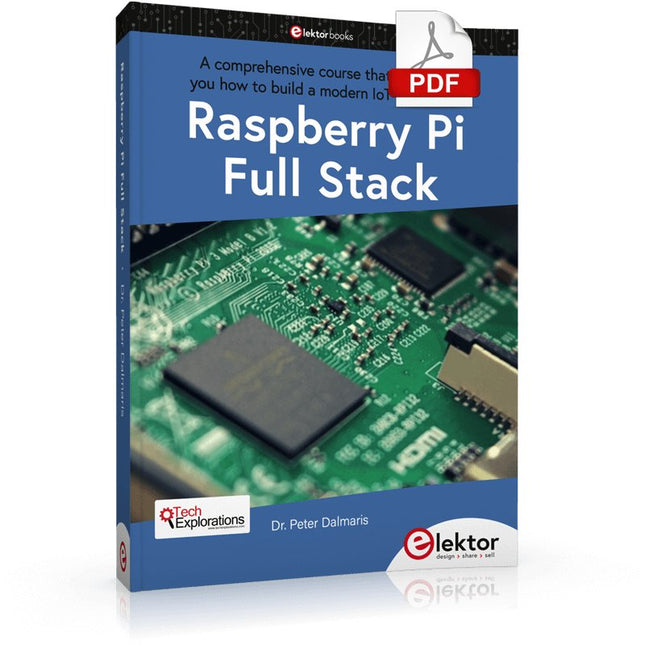
Elektor Digital Raspberry Pi Full Stack (E-book)
Dieses Buch nimmt Sie mit auf eine spannende Tour durch die Entwicklung von Full-Stack-Webanwendungen mit Raspberry Pi. Sie lernen, wie Sie eine Anwendung von Grund auf erstellen. Sie erwerben Erfahrung und Wissen über Technologien, darunter: Das Linux-Betriebssystem und die Befehlszeile. Die Programmiersprache Python. Die GPIOs (General Purpose Input Output Pins) des Raspberry Pi. Der Nginx-Webserver. Flask Python-Mikroframework für Webanwendungen. JQuery und CSS zum Erstellen von Benutzeroberflächen. Umgang mit Zeitzonen. Erstellen von Diagrammen mit Plotly und Google Charts. Datenerfassung mit Google Sheet. Entwickeln von Applets mit IFTTT. Sichern Sie Ihre Anwendung mit SSL. Empfangen Sie mit Twilio Textnachrichten auf Ihrem Telefon. In diesem Buch erfahren Sie außerdem, wie Sie einen drahtlosen Arduino-Sensorknoten aus der Ferne einrichten und Daten von ihm sammeln. Ihre Raspberry Pi-Webanwendung kann Arduino-Knotendaten auf die gleiche Weise verarbeiten, wie sie Daten von ihrem integrierten Sensor verarbeitet. Raspberry Pi Full Stack vermittelt Ihnen viele Fähigkeiten, die für die Erstellung von Web- und Internet-of-Things-Anwendungen unerlässlich sind. Die Anwendung, die Sie in diesem Projekt erstellen, ist eine Plattform, die Sie erweitern können. Dies ist nur der Anfang dessen, was Sie mit einem Raspberry Pi und den Software- und Hardwarekomponenten tun können, die Sie lernen werden. Dieses Buch wird vom Autor durch einen eigenen Diskussionsbereich unterstützt.
€ 34,95
Mitglieder € 27,96
-
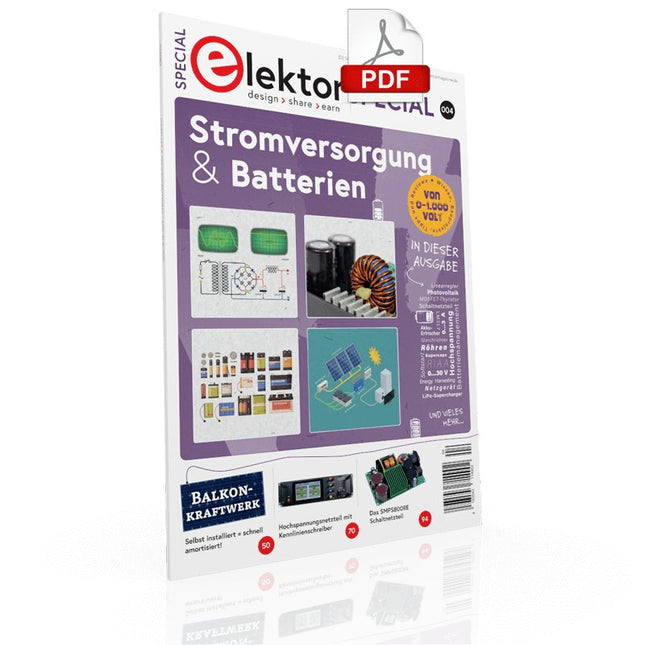
Elektor Digital Elektor Special: Stromversorgung & Batterien (PDF)
Der einfache „Stromversorgung“ genannte Schaltungsteil wird sowohl bei der Entwicklung als auch bei der Reparatur von Elektronik enorm unterschätzt. Dabei ist die Vielfalt bei Netzteilen oder neudeutsch „PSU“ enorm. Es gibt sie in den unterschiedlichsten Ausführungen: mit Gleich- oder Wechselspannung, als Generator, Akku oder Batterie, als Solar-Panel, extern oder eingebaut, linear oder „geschaltet“ – um nur einige zu nennen. Auch die Leistungsbereiche sind enorm: von Nano-Ampere bis Kilo-Ampere – dasselbe gilt für Spannungen. Bei der konkreten Umsetzung kann man zwischen ICs oder diskreten Bauteilen, zwischen fertigem Gerät bzw. Modul oder der Realisierung aus selbstverlöteten Bauteilen wählen. Dieses Special deckt die wichtigsten Merkmale und Gestaltungsaspekte von Stromversorgungen ab. Inhalt Grundlagen Batteriemanagement Was man beim Einsatz von (Lithium-)Akkus beachten muss. Festspannungsnetzgerät mit Linearregler Das beste Ergebnis gleich nach den Batterien. Lichtenergie sammeln Wie man ein Solarmodul für ein Energy-Harvesting-Projekt verwenden kann. Netzbetriebene Versorgungsgeräte Basisschaltungen und Tipps für Transformatoren, Gleichrichtung, Siebung und Stabilisierung. Sanftanlauf Der hohe Einstrompuls sollte vermieden werden. Steuerbarer Gleichrichter Einige Vorschläge, um die Verlustleistung im Längsregler möglichst gering zu halten. Komponenten Arbeitsblatt: Spannungsreglerserie LM117 / LM217 / LM317 Superkondensatoren Bewertungen Labornetzteil-Kit Joy-iT RD6006 Elektronische Last Siglent SDL1020X-E Projekte Balkon-Kraftwerk Selbst installiert = schnell amortisiert! DIY-LiPo-Kompressor-Kit Vom Prototyp zum Massenmarkt. Doppelanoden-MOSFET-Thyristor Schneller und effizienter als herkömmliche SCRs. Batterie-Entsafter Nicht wegwerfen, ausquetschen! Hochspannungsnetzteil mit Kennlinienschreiber Spannungen bis 400 V einstellen und Kennlinien für Röhren und Transistoren erstellen. Hochspannungsnetzteil Für RIAA-Röhrenvorverstärker und andere Anwendungen. Mikroversorgung Eine Laborstromversorgung für universelle Anwendungen. Phantom-Speisung mit geschalteten Kondensatoren Spannungsverdreifachung mit zwei ICs. Das SMPS800RE Schaltnetzteil für den Elektor Fortissimo-100 Zuverlässig, leicht und unkompliziert. Weicher Start Schont das Netzgerät und die Last. UniLab 2 Geschaltetes Labornetzteil 0…30 V/3 A Tipps Softstart für Step-Down-Schaltregler Stromabschaltung mit minimalen Verlusten Powerbank-Geheimnisse Künstliche Masse Akku-Erfrischer Akkupack-Entlader Parallelschaltung von Spannungsreglern
€ 11,90
Mitglieder € 10,71
-
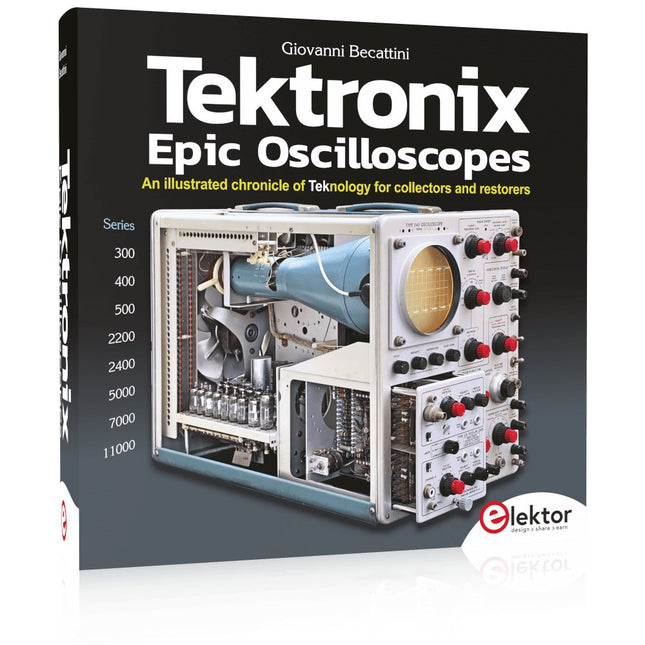
Elektor Publishing Tektronix Epic Oscilloscopes
Eine illustrierte Chronik der Teknologie für Sammler und Restauratoren Oszilloskope haben einen wichtigen Beitrag zum Fortschritt des menschlichen Wissens geleistet, nicht nur in der Elektronik, sondern in allen Wissenschaften, wann immer eine physikalische Größe in ein zeitbezogenes elektrisches Signal umgewandelt werden kann. Dieses Buch zeichnet die Geschichte eines wichtigen Instruments anhand vieler Tektronix-Produkte nach. Dieses Unternehmen hat die meisten der Funktionen, die heute in allen Oszilloskopen zu finden sind, erfunden und patentiert. Tek ist und wird immer ein Synonym für das Oszilloskop sein. Auf fast 600 Seiten, mit Hunderten von prächtigen Fotos, Diagrammen, Anekdoten und technischen Daten, reisen Sie durch die Geschichte von Tektronix in einer hervorragenden Sammlerausgabe mit einem technischen Blickwinkel. Der Autor scheut sich nicht, sich die Hände schmutzig zu machen und seine eigenen Tek-Geräte zu restaurieren. Die Reise beginnt in den frühen 1950er Jahren. Sie endet in den 90er Jahren, nachdem er die interessantesten Modelle der 300er-, 400er-, 500er-, 5000er-, 7000er- und 11000er-Serie, von Röhren bis hin zu fortschrittlichen Hybridtechnologien, in allen Einzelheiten vorgestellt hat. Downloads NEU: Gratis Supplement (136 Seiten, 401 MB)
€ 79,95
Mitglieder € 71,96
-

Wemos WeMos D1 mini Pro - ESP8266 based WiFi Module
Dieses Mini-WLAN-Board verfügt über 16 MB Flash, einen externen Antennenanschluss und eine integrierte Keramikantenne basierend auf ESP8266EX. Merkmale 11 digitale Ein-/Ausgangspins Interrupt/pwm/I²C/eindrahtig 1 Analogeingang (3,2 V max. Eingang) 16 MB Flash Externer Antennenanschluss Eingebaute Keramikantenne CP2104 USB-TO-UART-IC Spezifikationen Betriebsspannung 3,3 V Digitale I/O-Pins 11 Analoge Eingangspins 1 (3,2 V max.) Taktfrequenz 80/160 MHz Blitz 16 MB Größe 34,2 x 25,6 mm Gewicht 3 g Pin-Konfiguration Stift Funktion ESP8266-Pin RX RXD RXD A0 Analogeingang, max. 3,2 V A0 D0 IO GPIO16 D1 IO, SCL GPIO5 D2 IO, SDA GPIO4 D3 IO, 10-km-Pull-up GPIO0 D4 IO, 10k Pullup, BUILTIN_LED GPIO2 D5 IO, SCK GPIO14 D6 IO, MISO GPIO12 D7 IO, MOSI GPIO13 D8 IO, 10k Pulldown, SS GPIO15 G Boden GND 5V 5 V - 3V3 3,3 V 3,3 V RST Zurücksetzen RST Inbegriffen 1x WeMos D1 mini Pro (basierend auf ESP8266EX) 2x Stiftleiste (kurz) 2x Buchsenleiste (kurz) 2x Buchsenleiste (lang)
€ 14,95€ 7,50
Mitglieder identisch
-
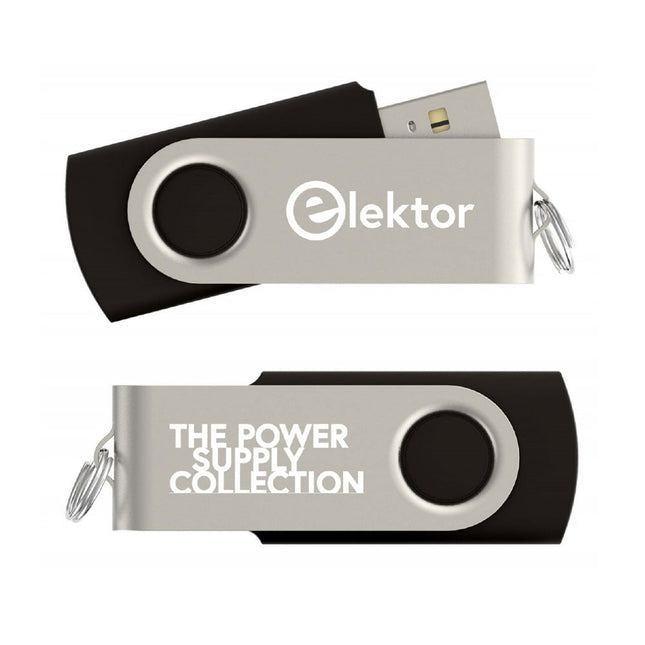
Elektor Classics The Elektor Power Supply Collection (USB-Stick)
Mehr als 200 Stromversorgungslösungen fürs Zuhause Dieser USB-Stick enthält über 200 verschiedene Stromversorgungsschaltungen aus den Elektor Jahrgängen 2001-2022. Mit der Artikelsuchfunktion können Sie Volltextinhalte durchsuchen. Die Ergebnisse werden immer als vorformatierte PDF-Dokumente angezeigt. Highlights Cuk-Konverter Automatische Batterieumschaltung Batteriespannungs-LED Digitales Tischnetzteil Lithium-Ionen-Ladegerät Solarzellen-Ladegerät Elektronische Sicherung Hochspannungsregler Netzteil für USB-Geräte Aufwärtswandler für LEDs Batteriemanagement und vieles mehr... Auf dem Stick finden Sie auch einen Ordner mit zusätzlichem Material wie Platinenlayouts, Gerber-Dateien und Software.
€ 49,95€ 24,95
Mitglieder identisch
-
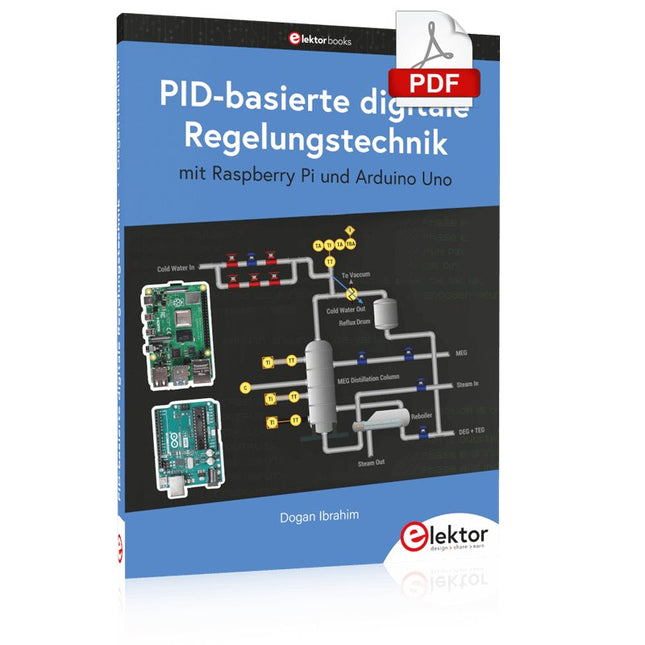
Elektor Digital PID-basierte digitale Regelungstechnik mit Raspberry Pi und Arduino Uno (PDF)
Der Arduino Uno ist ein Open-Source-Mikrocontroller-Entwicklungssystem, das Hardware, eine integrierte Entwicklungsumgebung (IDE) und eine Vielzahl von Bibliotheken umfasst. Es wird von einer riesigen Gemeinschaft von Programmierern, Elektronikern, Enthusiasten und Akademikern unterstützt. Insbesondere die Bibliotheken erleichtern die Programmierarbeit und reduzieren die Entwicklungszeiten, da sie das Erstellen von Programmen erheblich erleichtern. Der Raspberry Pi 4 kann in vielen Projekten wie Audio- und Videoanwendungen, aber auch in Industriesteuerungen, Robotik, Spielen usw. eingesetzt werden. Dazu bietet er auch WiFi- und Bluetooth-Fähigkeiten, wodurch er sich zudem hervorragend für internetbasierte Steuerungs- und Überwachungsanwendungen eignet. In diesem Buch werden sowohl der Raspberry Pi 4 als auch der Arduino Uno in PID-basierten automatischen Steuerungsanwendungen eingesetzt. Nach einer grundlegenden Theorie der Regelsysteme werden funktionierende und getestete Projekte zur Steuerung realer Systeme mit PID-Reglern vorgestellt. Die Open-Loop-Eigenschaften, die Abstimmung der PID-Parameter und das Closed-Loop-Zeitverhalten der Systeme werden zusammen mit Blockdiagrammen, Schaltplänen und PID-Regelalgorithmen ausführlich diskutiert. Vollständige Programme für den Raspberry Pi und den Arduino Uno runden die im Buch vorgestellten Projekte ab. Die Regelsysteme können problemlos auch auf andere Projekte angewendet werden und die für den Raspberry Pi 4 angegebenen Programme sollten auch mit anderen Modellen der Raspberry Pi-Familie reibungslos funktionieren. Das Buch behandelt folgende Themen: Steuer- und Regelsysteme Analoge und digitale Sensoren Übertragungsfunktionen und zeitkontinuierliche Systeme Systemantwortfunktionen erster und zweiter Ordnung Zeitdiskrete digitale Systeme Zeitkontinuierliche PID-Regler Zeitdiskrete PID-Regler Zweipunkt-Temperaturregelung mit Raspberry Pi und Arduino Uno PID-basierte Temperaturregelung mit Raspberry Pi und Arduino Uno Motorsteuerung mit Raspberry Pi und Arduino Uno Wasserstandsregelung mit Raspberry Pi und Arduino Uno PID-basierte LED-Helligkeitsregelung mit Raspberry Pi und Arduino Uno
€ 32,80
Mitglieder € 26,24
-
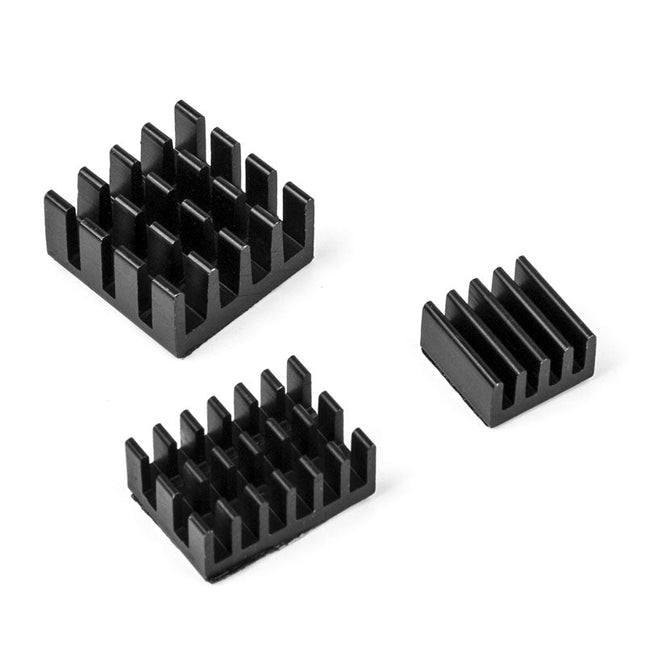
Kuongshun Kühlkörper-Set für Raspberry Pi (schwarz)
3-in-1 Aluminium-Kühlkörperset für Raspberry Pi 4 und 5 Lieferumfang 1x 14x14x6 mm 1x 15x10x5 mm 1x 8,8x8,8x5 mm
€ 3,95€ 2,95
Mitglieder identisch
-
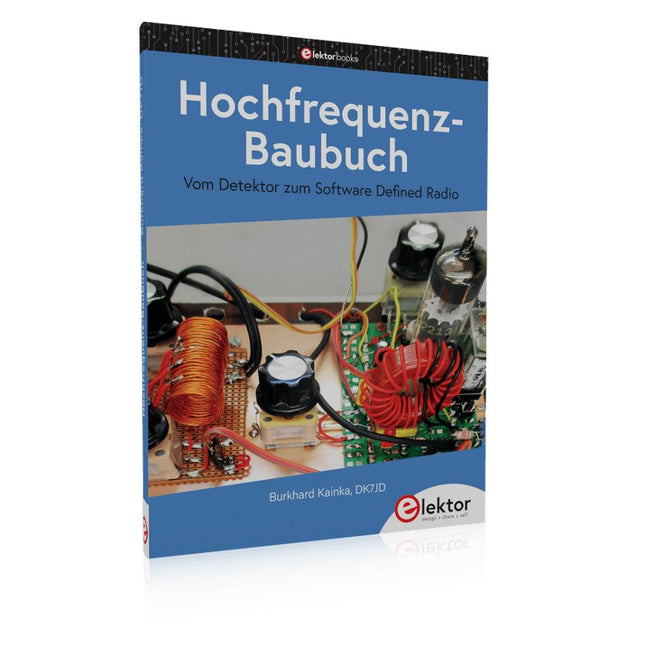
Elektor Publishing Hochfrequenz-Baubuch
Die Hochfrequenztechnik ist eines der Gebiete, auf denen man auch heute noch eigene Ideen in die Tat umsetzen kann. Unzählige Schaltungsvarianten mit besonderen Zielsetzungen geben Raum für sinnvolle Experimente und Projekte. Vieles kann man nicht einfach kaufen. Detektorradios ohne eigene Energiequelle, einfache Röhrenempfänger mit einem Hauch von Nostalgie, die ersten Empfangsversuche mit dem Software Defined Radio oder Spezialempfänger für den Amateurfunk, all dies lässt sich mit wenig Aufwand realisieren. Lange Zeit war das Radiobasteln der Einstieg in die Elektronik. Inzwischen gibt es auch andere Wege, vor allem über Computer, Mikrocontroller und die Digitaltechnik. Allerdings kommen die analogen Wurzeln der Elektronik oft zu kurz. Die Radiotechnik eignet sich besonders gut als Lernfeld der Elektronik, weil man hier mit den einfachsten Grundlagen beginnen kann. Aber auch die Verbindung zur modernen Digitaltechnik liegt auf der Hand, wenn es z. B. um moderne Abstimmverfahren wie PLL und DDS oder um moderne DSP-Radios geht. Dieses Buch gibt einen Überblick und stellt eine Sammlung einfacher Projekte vor. Der Autor möchte Sie dabei unterstützen, eigene Ideen zu entwickeln, eigene Empfänger zu entwerfen und sie zu erproben.
€ 39,80
Mitglieder identisch
-
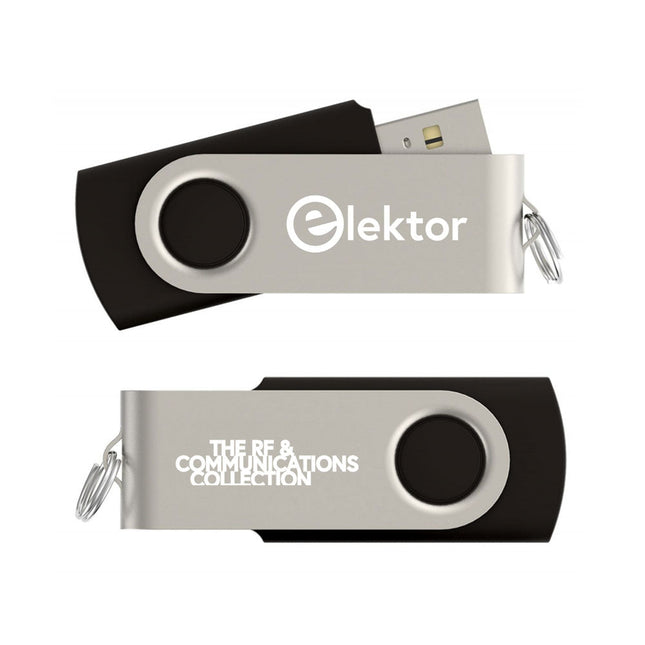
The RF & Communications Collection (USB-Stick)
Dieser USB-Stick enthält eine Auswahl von mehr als 350 Artikeln über HF, Funk und Kommunikation, die im Elektor-Magazin veröffentlicht wurden. Der Inhalt besteht sowohl aus Hintergrundartikeln als auch aus Projekten zu den folgenden Themen: Grundlegende funkbezogene Schaltungen sowie komplexere Schaltungen wie Filter, Oszillatoren und Verstärker. Entwurf, Konstruktion und Theorie von Antennen zum effizienten Senden und Empfangen von Funksignalen. Entwurf und Analyse von RF-Schaltungen einschließlich Filtern, Mischern, PLLs und Frequenzsynthesizern. Werkzeuge und Techniken zur Vorhersage der Ausbreitungswege von Funkwellen und zur Messung der RF-Signalstärke. Techniken zur Verarbeitung digitaler Signale in HF-Systemen, einschließlich Modulations- und Demodulationsverfahren. Projekte zu Funkempfängern, AM, FM, SSB, CW, DRM, DAB, DAB+, Software Defined Radio und mehr. Projekte zu Wi-Fi, Bluetooth, LoRaWAN und mehr. Sie können die Artikelsuchfunktion nutzen, um bestimmte Inhalte im Volltext zu finden. Die Ergebnisse werden immer als vorformatierte PDF-Dokumente angezeigt. Mit Adobe Reader können Sie die Artikel durchblättern und mit der integrierten Suchfunktion von Adobe Reader nach einzelnen Wörtern und Ausdrücken suchen.
€ 49,95€ 24,95
-

Elektor Digital Nucleo Boards Programmierung mit der STM32CubeIDE (E-Book)
Hands-on in more than 50 projects STM32 Nucleo family of processors are manufactured by STMicroelectronics. These are low-cost ARM microcontroller development boards. This book is about developing projects using the popular STM32CubeIDE software with the Nucleo-L476RG development board. In the early Chapters of the book the architecture of the Nucleo family is briefly described. The book covers many projects using most features of the Nucleo-L476RG development board where the full software listings for the STM32CubeIDE are given for each project together with extensive descriptions. The projects range from simple flashing LEDs to more complex projects using modules, devices, and libraries such as GPIO, ADC, DAC, I²C, SPI, LCD, DMA, analogue inputs, power management, X-CUBE-MEMS1 library, DEBUGGING, and others. In addition, several projects are given using the popular Nucleo Expansion Boards. These Expansion Boards plug on top of the Nucleo development boards and provide sensors, relays, accelerometers, gyroscopes, Wi-Fi, and many others. Using an expansion board together with the X-CUBE-MEMS1 library simplifies the task of project development considerably. All the projects in the book have been tested and are working. The following sub-headings are given for each project: Project Title, Description, Aim, Block Diagram, Circuit Diagram, and Program Listing for the STM32CubeIDE. In this book you will learn about STM32 microcontroller architecture; the Nucleo-L476RG development board in projects using the STM32CubeIDE integrated software development tool; external and internal interrupts and DMA; DEBUG, a program developed using the STM32CubeIDE; the MCU in Sleep, Stop, and in Standby modes; Nucleo Expansion Boards with the Nucleo development boards. What you need a PC with Internet connection and a USB port; STM32CubeIDE software (available at STMicroelectronics website free of charge) the project source files, available from the book’s webpage hosted by Elektor; Nucleo-L476RG development board; simple electronic devices such as LEDs, temperature sensor, I²C and SPI chips, and a few more; Nucleo Expansion Boards (optional).
€ 39,95
Mitglieder € 31,96
-

Elektor Special: Sensoren für Wetter und Umwelt
Bauen Sie Ihre perfekte Wetterstation oder forschen Sie zusammen mit der ganzen Welt an Umweltdaten. Mit vielen praktischen Projekten für Arduino, Raspberry Pi, NodeMCU, ESP32 und weiteren Developmentboards. Wetterstationen erfreuen sich seit Jahrzehnten großer Beliebtheit. Ob in aktuellen oder längst eingestellten Elektronik-Magazinen – regelmäßig finden sich Beiträge zum Eigenbau einer Wetterstation. Im Laufe der Jahre wurden diese Systeme immer ausgefeilter und können heute nahtlos in das Smart Home integriert werden. Allerdings erfordert dies oft die Bindung an einen (teuren) Markenhersteller, der sämtliche Komponenten abdeckt. Mit Ihrer eigenen Wetterstation können Sie jedoch mühelos mithalten – und sogar Messwerte erfassen, die kommerzielle Geräte nicht bieten. Dabei kommt der Spaß nicht zu kurz: Sie erweitern spielerisch Ihr Wissen über Elektronik, moderne Mikrocontroller-Developmentboards und Programmiersprachen. Schon für weniger als zehn Euro können Sie erste Umweltdaten erfassen und Ihr System Schritt für Schritt mit wachsendem Interesse weiter ausbauen. Aus dem Inhalt: Wind und Wetter auf der Spur Wetterdisplay mit OpenWeatherMap und Vakuum-Fluoreszenzanzeige Flüchtige organische Verbindungen in der Atemluft Mit MQ-Sensoren arbeiten: Kohlenmonoxid messen – geruchlos aber extrem giftig CO2-Ampel mit ThingSpeak-IoT-Anbindung Ein Gießautomat für Ihre Pflanzen Gutes Raumklima: Temperatur und Luftfeuchtigkeit sind wichtige Kriterien Schickes Thermometer mit alter Röhrentechnik Nostalgisches Wetterhäuschen für die ganze Familie Luftdruck und Temperatur genau messen Sonnenbrand-Warngerät DIY-Sensor für die Sonnenscheindauer Das Smartphone zeigt’s an: Nebel oder klare Sicht? Erdbeben erkennen Pegelstände von Gewässern und Behältern pH-Wert von Gewässern bestimmen Radioaktive Strahlung erkennen Mit GPS wissen Sie weltweit, wo ihr Sensor ist Logdateien mit Zeitstempel auf SD-Karten speichern LoRaWAN, The Things Network und ThingSpeak LoRaWAN-Gateway für TTN betreiben Mega-Display mit Wettervorhersage
€ 14,90
Mitglieder € 13,41
-
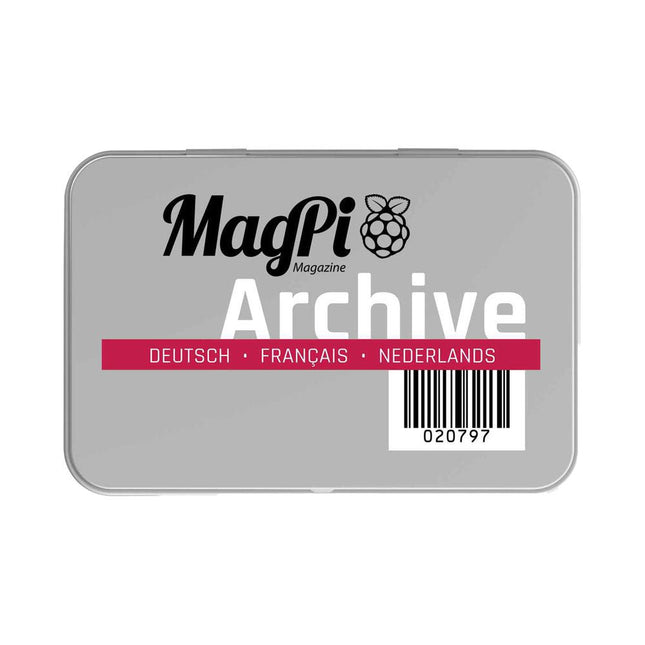
MagPi Archiv (USB-Stick)
Über 8 MagPi Jahrgänge (2016 bis 2024) auf USB-Stick Dieser USB-Stick enthält alle MagPi Ausgaben der Jahrgänge 2016 bis Januar/Februar 2024 sowie 2 Elektor-Kompilationen mit Raspberry Pi-Schaltungen im PDF-Format. Die neueste Ausgabe (März/April 2024) kann jedoch bereits jetzt für jedermann kostenlos heruntergeladen werden. MagPi ist das offizielle Magazin der Raspberry Pi Foundation und enthält Reviews, Tutorials und DIY-Projekte über und mit dem Raspberry Pi.
€ 69,95€ 19,95
Mitglieder identisch
-
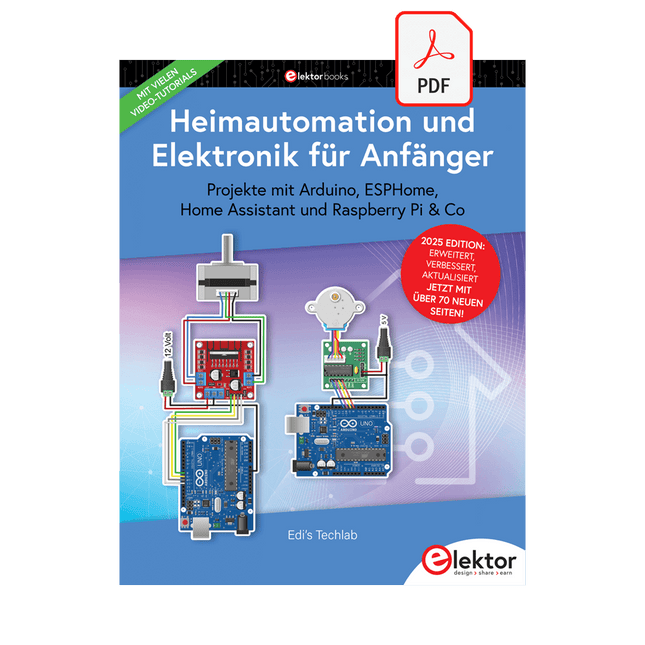
Elektor Digital Heimautomation und Elektronik für Anfänger (PDF)
Projekte mit Arduino, ESPHome, Home Assistant und Raspberry Pi & Co Dieses E-Book enthält verschiedene Projektbeispiele und beginnt mit einer Einführung in die Elektronik. Es erklärt unter anderem, wie man Home Assistant auf einem Raspberry Pi installiert, wie man Raumklimasensoren für Temperatur und Luftfeuchtigkeit nutzt, das MQTT-Protokoll sowie weitere Schnittstellen einsetzt und ESPHome verwendet, um Sensoren und Aktoren in Home Assistant zu integrieren. Zahlreiche Video-Tutorials ergänzen das Buch. Grundlagen der Elektrotechnik Das Buch beginnt mit einer Einführung in die Elektrotechnik. Ihr lernt die Grundlagen von Spannung, Strom, Widerständen, Dioden und Transistoren. Arduino und Mikrocontroller Ein kompletter Abschnitt widmet sich dem Arduino Uno. Ihr lernt den Aufbau kennen, schreibt erste Programme und erarbeitet praktische Beispiele. Home Assistant und Automatisierung Ihr erfahrt, wie Home Assistant auf einem Raspberry Pi eingerichtet wird, und lernt den Umgang mit Automatisierungen, Szenen und Geräten. Zusätzlich wird auf Zigbee, MQTT und ESP-NOW eingegangen – wichtige Technologien für die Heimautomation. ESP8266, ESP32 und ESP32-CAM Die beliebten ESP-Mikrocontroller werden ausführlich behandelt. Nach einer theoretischen Einführung folgen praktische Projekte, die euch zeigen, wie ihr das Beste aus diesen Geräten herausholen könnt. Sensoren und Aktoren Das Buch erklärt die Funktionsweise und Anwendung zahlreicher Sensoren wie Temperatur- und Luftfeuchtigkeitssensoren, Bewegungsmelder und RFID-Reader. Bei den Aktoren werden Schrittmotoren, e-ink Displays, Servo-Motoren und vieles mehr beleuchtet. Zu allen Geräten gibt es praxisnahe Anwendungsbeispiele. ESPHome Dieses Kapitel zeigt euch, wie ihr Sensoren und Aktoren ohne Programmieraufwand in Home Assistant integriert. Ihr werdet Schritt für Schritt durch die Einrichtung mit ESPHome geführt. LEDs und Lichttechnik In diesem Kapitel lernt ihr verschiedene LED-Typen und deren Einsatzmöglichkeiten kennen. Grundlagen der Lichttechnik werden ebenfalls erklärt. Node-RED Ein eigenes Kapitel ist Node-RED gewidmet. Ihr erlernt die Grundlagen dieses leistungsstarken Tools und werdet Schritt für Schritt durch die Einrichtung und Nutzung geführt. Integrierte Schaltkreise (ICs) In der Elektronik gibt es zahlreiche ICs, die uns das Leben erleichtern. Ihr lernt die wichtigsten kennen und wendet das Wissen in praktischen Projekten an. Programmieren für Profis Fortgeschrittene Themen wie die korrekte Verwendung von Tastern, der Einsatz von Interrupts und die Nutzung eines NTP-Servers für Zeit-Synchronisation werden in diesem Kapitel detailliert behandelt. Downloads GitHub
€ 49,95€ 39,95
Mitglieder identisch
-
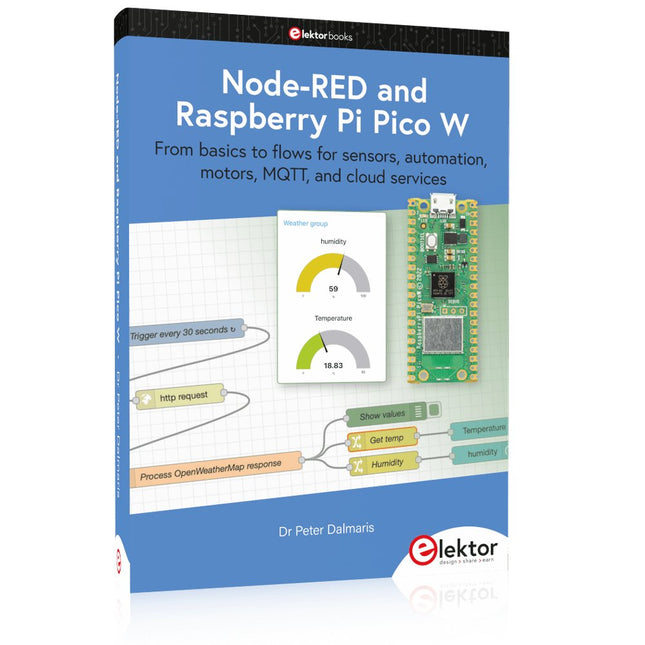
Elektor Publishing Node-RED and Raspberry Pi Pico W
From basics to flows for sensors, automation, motors, MQTT, and cloud services This book is a learning guide and a reference. Use it to learn Node-RED, Raspberry Pi Pico W, and MicroPython, and add these state-of-the-art tools to your technology toolkit. It will introduce you to virtual machines, Docker, and MySQL in support of IoT projects based on Node-RED and the Raspberry Pi Pico W. This book combines several elements into a platform that powers the development of modern Internet of Things applications. These elements are a flow-based server, a WiFi-enabled microcontroller, a high-level programming language, and a deployment technology. Combining these elements gives you the tools you need to create automation systems at any scale. From home automation to industrial automation, this book will help you get started. Node-RED is an open-source flow-based development tool that makes it easy to wire together devices, APIs, and online services. Drag and drop nodes to create a flowchart that turns on your lights at sunset or sends you an email when a sensor detects movement. Raspberry Pi Pico W is a version of the Raspberry Pi Pico with added 802.11n Wi-Fi capability. It is an ideal device for physical computing tasks and an excellent match to the Node-RED. Quick book facts Project-based learning approach. Assumes no prior knowledge of flow-based programming tools. Learn to use essential infrastructure tools in your projects, such as virtual machines, Docker, MySQL and useful web APIs such as Google Sheets and OpenWeatherMap. Dozens of mini-projects supported by photographs, wiring schematics, and source code. Get these from the book GitHub repository. Step-by-step instructions on everything. All experiments are based on the Raspberry Pi Pico W. A Wi-Fi network is required for all projects. Hardware (including the Raspberry Pi Pico W) is available as a kit. Downloads GitHub
€ 49,95
Mitglieder € 44,96
-
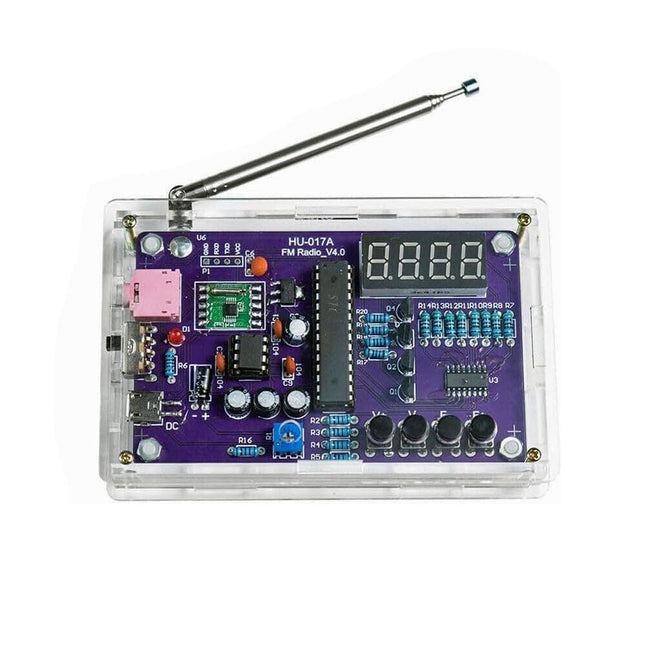
Generic FM Radio Kit
Dieses DIY-Kit (HU-017A) ist ein Wireless-FM-Radioempfänger mit einer 4-stelligen 7-Segment-Anzeige. Es arbeitet im globalen FM-Empfangsfrequenzbereich von 87,0-108,0 MHz, was es für die Verwendung in jedem Land oder jeder Region geeignet macht. Das Kit bietet zwei Stromversorgungsmodi, sodass Sie es sowohl zu Hause als auch im Freien nutzen können. Dieses DIY-Elektronikprodukt wird Ihnen helfen, Schaltungen zu verstehen und Ihre Lötfähigkeiten zu verbessern. Features 87,0-108,0 MHz FM-Radio: Eingebauter FM-Datenprozessor RDA5807 mit einem Standard-FM-Empfangsfrequenzband. Die UKW-Frequenz kann mit den Tasten F+ und F- eingestellt werden. Einstellbare Lautstärke: Zwei Methoden zur Lautstärkeregelung – Taste und Potentiometer. Es gibt 158 Lautstärkestufen. Aktiv & Passiver Audioausgang: Das Kit verfügt über einen integrierten 0,5 W-Leistungsverstärker, um 8 Ω-Lautsprecher direkt anzutreiben. Außerdem gibt es Audiosignale an Headsets oder Lautsprecher mit AUX-Schnittstellen aus und ermöglicht so das persönliche Hören und Teilen von FM-Audio. Konfiguriert mit einer 25-cm-UKW-Antenne und einem roten 4-stelligen 7-Segment-Display für die Echtzeitanzeige der UKW-Radiofrequenz. Die transparente Acrylschale schützt die interne Leiterplatte. Es unterstützt zwei Stromversorgungsmethoden – 5 V USB und 2x 1,5 V (AA) Batterien. DIY-Handlöten: Das Kit enthält verschiedene Komponenten, die manuell installiert werden müssen. Es hilft beim Üben und Verbessern der Lötfähigkeiten und eignet sich daher für Elektronik-Bastler, Anfänger und Ausbildungszwecke. Technische Daten Betriebsspannung DC 3 V/5 V Ausgangsimpedanz 8 Ω Ausgangsleistung 0,5 W Ausgabekanal Mono Empfängerfrequenz 87,0 MHz~108,0 MHz Frequenzgenauigkeit 0,1 MHz Betriebstemperatur −40°C bis +85°C Betriebsfeuchtigkeit 5% bis 95% relative Luftfeuchtigkeit Abmessungen 107 x 70 x 23 mm WICHTIG: Entfernen Sie die Batterien, wenn Sie das Radio über USB mit Strom versorgen! Lieferumfang 1x Platine 1x RDA5807M FM-Empfänger 1x STC15W404AS MCU 1x IC-Sockel 1x 74HC595D Register 1x TDA2822M Verstärker 1x IC-Sockel 1x AMS1117-3,3V Spannungswandler 18x Metallschichtwiderstand 1x Potentiometer 4x Keramikkondensator 5x Elektrolytkondensator 4x S8550-Transistor 1x Rote LED 1x 4-stelliges 7-Segment-Display 1x Kippschalter 1x SMD-Micro-USB-Buchse 1x Radioantenne 1x AUX-Audio-Buchse 4x Schwarzer Knopf 4x Knopfkappe 1x 0,5 W/8 Ω Lautsprecher 1x Rot/schwarzes Kabel 2x Doppelseitiger Kleber 1x AA-Batteriebox 1x USB-Kabel 6x Acryltafel 4x Nylon-Säulenschraube 4x M3-Schraube 4x M3 Mutter 4x M2x22 mm Schraube 1x M2x6 mm Schraube 5x M2-Mutter
€ 29,95
Mitglieder € 26,96
-
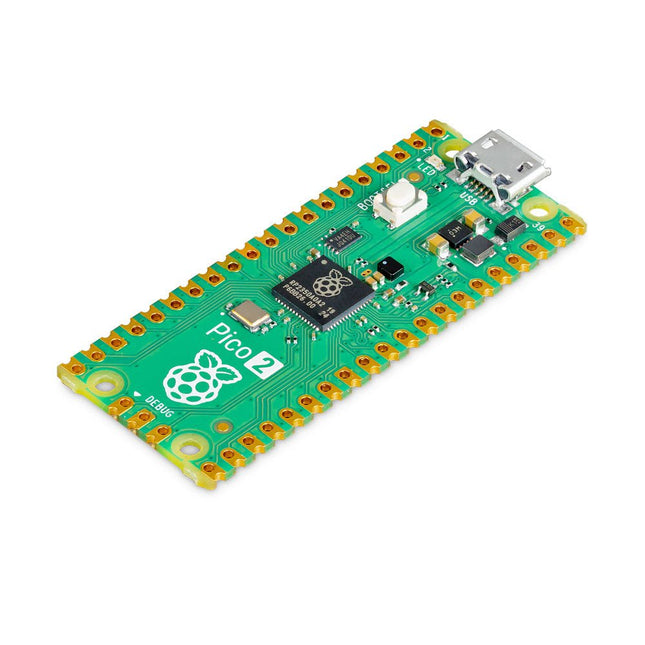
Raspberry Pi Foundation Raspberry Pi Pico 2
Der Raspberry Pi Pico 2 ist ein neues Mikrocontroller-Board der Raspberry Pi Foundation, basierend auf dem RP2350. Es verfügt über eine höhere Kerntaktrate, doppelt so viel On-Chip-SRAM, doppelt so viel On-Board-Flash-Speicher, leistungsstärkere Arm-Kerne, optionale RISC-V-Kerne, neue Sicherheitsfunktionen und verbesserte Schnittstellenfunktionen. Der Raspberry Pi Pico 2 bietet eine deutliche Steigerung der Leistung und Funktionen und behält gleichzeitig die Hardware- und Softwarekompatibilität mit früheren Mitgliedern der Raspberry Pi Pico-Serie bei. Der RP2350 bietet eine umfassende Sicherheitsarchitektur rund um Arm TrustZone für Cortex-M. Es umfasst signiertes Booten, 8 KB Antifuse-OTP für die Schlüsselspeicherung, SHA-256-Beschleunigung, einen Hardware-TRNG und schnelle Glitch-Detektoren. Die einzigartige Dual-Core- und Dual-Architektur-Fähigkeit des RP2350 ermöglicht Benutzern die Wahl zwischen einem Paar ARM Cortex-M33-Kernen nach Industriestandard und einem Paar Hazard3 RISC-V-Kernen mit offener Hardware. Der Raspberry Pi Pico 2 ist in C/C++ und Python programmierbar und wird durch eine ausführliche Dokumentation unterstützt. Er ist das ideale Mikrocontroller-Board sowohl für Enthusiasten als auch für professionelle Entwickler. Technische Daten CPU Dual Arm Cortex-M33 oder Dual RISC-V Hazard3 Prozessoren bei 150 MHz Speicher 520 KB On-Chip-SRAM; 4 MB integrierter QSPI-Flash Schnittstellen 26 Mehrzweck-GPIO-Pins, darunter 4, die für AD verwendet werden können Peripheriegeräte 2x UART 2x SPI-Controller 2x I²C-Controller 24x PWM-Kanäle 1x USB 1.1-Controller und PHY, mit Host- und Geräteunterstützung 12x PIO-Zustandsmaschinen Eingangsspannung 1,8-5,5 V DC Abmessungen 21 x 51 mm Downloads Datasheet (Pico 2) Datasheet (RP2350)
€ 5,95
Mitglieder identisch























